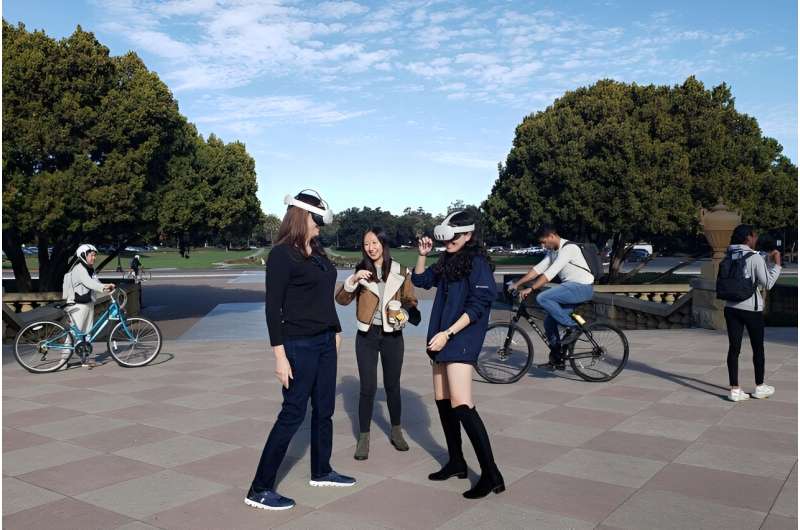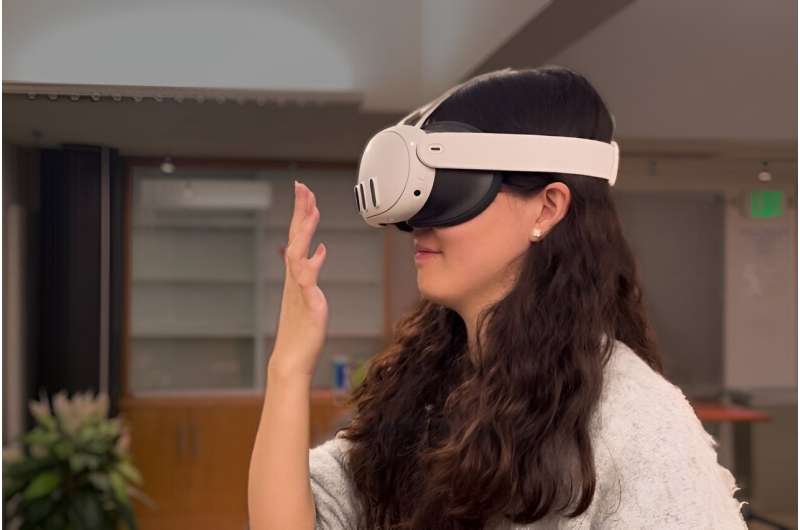This article has been reviewed according to Science X's editorial process and policies. Editors have highlighted the following attributes while ensuring the content's credibility:
fact-checked
trusted source
proofread
Researchers take new 'mixed reality' headsets for a spin

Among the buzziest consumer technologies right now are "mixed reality" or "spatial computing" headsets that convincingly blend views of the real world with digital content.
A key enabling technology behind these gizmos is passthrough video, which involves blocking out all light so users must rely on cameras on the headsets to see the external world around them via real-time video playing on tiny screens. The arrangement allows users to physically interact with their environments and go about daily activities but with added digital content displayed, ranging from familiar device apps to innovative gaming scenarios. If tech companies' visions come true, users would wear these headsets for extended periods, even all day long at work and at home, ushering in new modes of human-computer and social interaction.
To put passthrough video through its paces, a diverse team of Stanford researchers recently conducted field tests alongside longitudinal analyses of their personal journeys and interpersonal interactions. As described in a new study in Technology, Mind, and Behavior, overall user experiences proved—fittingly enough—mixed, with moments of both awe and unsettlement. The researchers accordingly recommend caution regarding prolonged headset use and call for a longer-term assessment.
"Given how far headsets with passthrough video have come, it's time to dedicate serious academic thought to the psychological and behavioral effects of this technology," said Jeremy Bailenson, the Thomas More Storke Professor in the Stanford School of Humanities and Sciences and founding director of the Virtual Human Interaction Lab (VHIL). "We want to understand the implications of living in a life in which we rely on passthrough for hours every day to see the world around us."
Pros of passthrough
For the study, 10 research scholars in the VHIL and Bailenson himself spent at least 140 minutes over two or three sessions wearing Meta Quest 3 passthrough video headsets, which became widely available in October 2023.
The researchers engaged in a wide range of activities such as having conversations, walking outdoors, playing games, and eating and cooking food. For safety reasons, given concerns about potentially tripping over objects or encountering moving people or vehicles, a chaperone not wearing a headset remained present at all times.
The study participants attempted to examine the experience from both a hands-on, subjective perspective as well as a removed, clinical view. "We took an observational approach, more akin to naturalists, and really dove into the medium in an exploratory way," said study co-author James Brown, a master's student in the Symbolic Systems Program.
In general, the researchers found they enjoyed many aspects of having reality filtered through passthrough. "For a lot of us, wearing a headset in public was exciting," said study co-author Monique Tania Santoso, a doctoral student in the Department of Communication.
"It was a very novel experience being in these headsets while walking around campus, interacting with strangers, and even buying coffee," said co-author Portia Wang, a second-year master's student in the Management Science and Engineering Department studying computational social science.
As for Bailenson, who has long followed the development of passthrough video and recalls first donning a rudimentary device back in the late 1990s, the experience was "mind-blowing" in comparison.
"It's hard to describe until you try it, but it feels like magic with these newest headsets," Bailenson said. "The immediacy of the video, the stereo color, and the incredible visuals that can be rendered, including making walls or objects disappear—your eyes and brain for the most part can't tell the difference."

Still not as real as real
As the researchers continued to spend time immersed in passthrough video, however, significant imperfections became apparent that impacted how users felt and would likely pose problems for frequent headset wearing.
In the headset, peripheral vision is lost and users can only take in around half of what humans normally see. And the gadgets still cannot quite match the sharpness of natural vision. Distortion occurs as well—a sort of "funhouse mirror" effect with objects' shapes and dimensions appearing unnatural or morphing—and there was a just-noticeable lag in the display changing when users move their heads to a new view.
"Even though the world you are looking at is real, it certainly has a video-game-like 'otherness' to it," said Brown.
These issues manifested as users often underestimating distances to objects. For example, giving "high fives" proved challenging, and when users tried bringing a spoon to their mouths when eating, the headset view suggested the spoon had reached their lips, though, in reality, the spoon hovered a few inches away.
While headset wearers learned to account for these inaccuracies, what concerns Bailenson's team is the extent to which such overcompensation could linger after prolonged headset usage.
"The companies making these headsets want you to wear them all day, but what are the aftereffects and how long do they last?" Bailenson said. "A plausible scenario could be walking down a flight of stairs and you miss a step, or driving a car and you misjudge distances."
All these effects contributed to profound feelings of what is known in this research as "social absence." Instances of this included "challenges of discerning distant facial expressions," noted by Wang, and the "lack of eye gaze," reported by Santoso. "People in the outside world became very absent, as if we were watching them on TV," Bailenson said. "The person walking or cycling by or sitting near you didn't feel physically real."
A final problem the team encountered in their field tests was simulator sickness, a kind of motion sickness long-documented in virtual reality and first-person gaming.
"When your eyes see the world move one way, and your body experiences it differently, simulator sickness can follow," said Bailenson. "I was surprised because all 11 of us in this study are headset veterans, but even from relatively short periods of use, we tended to feel uncomfortable."
Adapting and moderating
Given their experiences, the Stanford researchers recommend that mixed reality headset users proceed cautiously as they adjust to the medium rather than dive into day-long binges.
Bailenson specifically advocates for users of mixed reality products—as well as the headset manufacturers themselves—to consider reducing the amount of time in the headset and taking breaks.
"There is great potential for passthrough video headsets across all kinds of applications," said Bailenson. "But there are pitfalls as well that can lessen the user experience, from feelings of social absence to motion sickness, and aftereffects that could possibly even be dangerous."
Bailenson is a professor in the Department of Communication, a senior fellow at Stanford Woods Institute for the Environment, and a member of Stanford Bio-X, the Wu Tsai Human Performance Alliance, and the Wu Tsai Neurosciences Institute.
Additional Stanford authors include Brian Beams, lab manager of VHIL; graduate students Cyan DeVeaux, Eugy Han, Tara Srirangarajan, and Yujie Tao; and postdoctoral scholar Anna C. M. Queiroz. Co-author Rabindra Ratan is from Michigan State University.
More information:
Jeremy N. Bailenson et al, Seeing the World through Digital Prisms: Psychological Implications of Passthrough Video Usage in Mixed Reality, Technology, Mind, and Behavior (2024).
vhil.stanford.edu/sites/g/file … y-of-passthrough.pdf





















